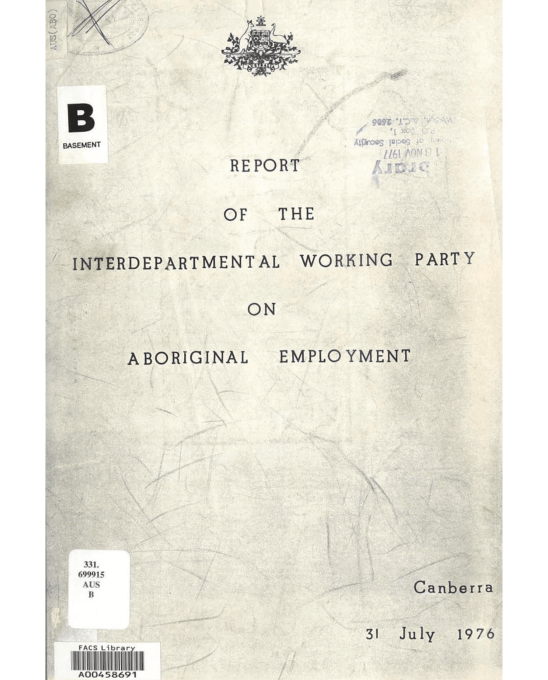
Report recommends Community Development and Employment Program
To address high unemployment rates, the government looked into ways to increase employment in Aboriginal communities. They considered introducing community-based work programs, but also looked into ways to make it harder to get Unemployment Benefit.
The Department of Social Security is not equipped to deal with Aboriginal welfare... it does not have first hand knowledge of the impact ... of unemployment benefit on Aboriginals
| Attachment | Size |
|---|---|
| iwp-employment-report.pdf | 2.19 MB |
| Attachment | Size |
|---|---|
| iwp-employment-report-plaintext.docx | 65.57 KB |
In 1973, Aboriginal people on missions and reserves gained access to Unemployment Benefit. With the high unemployment rates at the time, the government was under pressure to find solutions for Aboriginal unemployment in remote communities. Some people also raised concerns about the impacts they believed payments had on Aboriginal communities.
To look into these issues, the government formed the Interdepartmental Working Party on Aboriginal Employment (IWP) in 1976. The IWP included representatives from the federal departments of Aboriginal Affairs, Social Security, Education, and Employment and Industrial Relations. The report authors, who were mostly non-Indigenous, visited communities in South Australia, the Northern Territory and Western Australia and included their observations in the report.
The IWP published this report in their first year. The report included background on Aboriginal people’s access to government payments over time. It assessed whether Unemployment Benefit caused issues in Aboriginal communities and recommended solutions.
Perceived negative impacts of Unemployment Benefit
In their report, the IWP said that their main concern was that some Aboriginal people saw Unemployment Benefit as an ongoing payment. They said this was particularly common in communities where there weren’t many jobs available. In these cases the IWP said the payments became ‘a handout which increases dependency on others’.
While the report outlined possible negative impacts of Unemployment Benefit in communities, the authors warned there was no clear evidence. They wrote that payments were ‘only a contributing factor’, and said ‘… other factors include the erosion of Aboriginal culture caused by the inroads of western society’.
Follow-on reports such as the Miller report would agree that there was no proof that government payments alone caused social issues in communities.
Introduction of the Community Development and Employment Program
As one solution to Aboriginal unemployment, the IWP recommended beginning the Community Development and Employment Program (CDEP). Communities would work with the government to decide on CDEP projects, which would employ local people to work on them. The government would pay participants of the program the equivalent of Unemployment Benefit.
In 1985, the Miller report would recommend the continuation of CDEP as a successful program.
Strengthening the work test and the ‘willingness to move’ clause
The IWP also recommended strengthening the work test for people applying for Unemployment Benefit. The work test meant people had to prove they had tried to find a job before the government would pay them.
To strengthen the test, the IWP suggested reintroducing the ‘willingness to move’ clause. This would mean a person would need to agree to move for work to get a payment.
Leader of the Opposition, Gough Whitlam, would point out in a discussion in the House of Representatives that this failed to consider the strong connection Aboriginal people had to land. His government had removed the ‘willingness to move’ clause. He accused the government of the day of treating Aboriginal people with ‘callous indifference’ through this policy.
Future reports and an assessment of the IWP’s report
Future reports, such as the Miller report, found that many of the IWP’s recommendations were not implemented. While the Miller report argued that CDEP be continued, it was critical of other parts of the IWP report and recommended that self-determination be the foundation of future Aboriginal employment policy.
The only identified Aboriginal representative on the IWP was Dr Eric Willmot AM, who was at the time a Senior Education Officer at the Department of Education.
Permissions
Permission to reproduce excerpts from this report was granted by Haidi Willmot, the daughter of Dr Eric Willmot AM.
Citation
Interdepartmental Working Party on Aboriginal Employment (1976) Report of the Interdepartmental Working Party on Aboriginal Employment, 31 July 1976, Interdepartmental Working Party on Aboriginal Employment, Australian Government.
